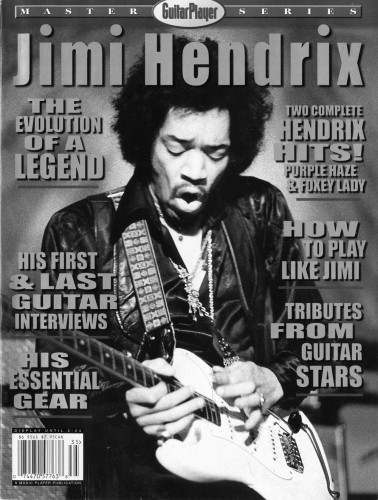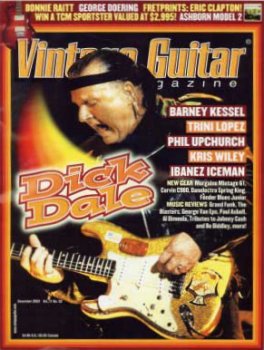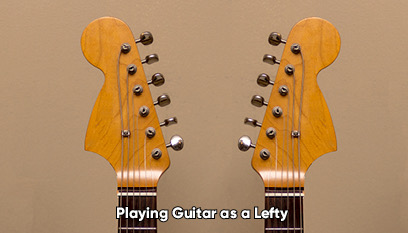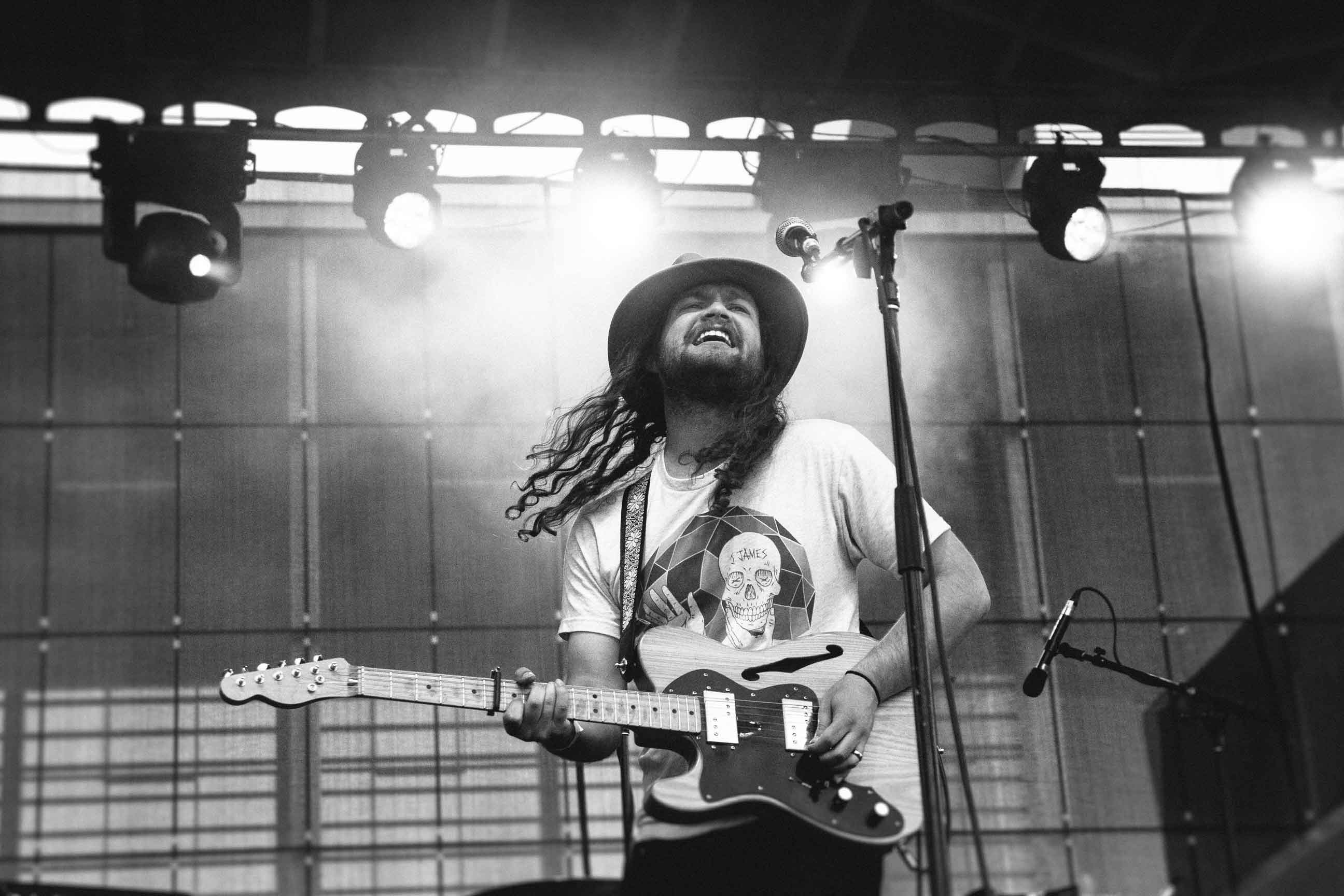
About 10% of people in the world are left-handed, but you probably can’t think of very many famous left-handed guitarists. That’s because many left-handed musicians play guitar the way a right-handed person would: with the left hand fretting chords and the right hand strumming.
So how do you play guitar left-handed? A lefty who’s interested in playing the guitar has three options:
- Play like a right-handed person would.
- Flip the guitar over and make chords with the right hand.
In this scenario, the strings would probably be re-strung so the low strings are closer to the player’s head and the treble strings are closer to the ground. Not all players who flip the guitar opt to re-string, though. - Play a guitar that was designed for left-handed players.
Advantages of Playing Right-Handed
You may wonder why any left-handed player would play right-handed. After all, we’re in the 21st century — it’s no longer cool to brand lefties as satanic freaks and force them to conform to the righty way of life. But playing guitar right-handed has a lot of practical advantages:
- You’ll use your dominant hand for making chords. For many players, strumming is easier than fretting chords — at least until they start learning complicated classical pieces or doing a lot of finger-picking or two-handed tapping.
- You’ll have far more options for guitars, and you’ll be able to play your friends’ guitars. Left-handed guitars tend to be more expensive and the selection is limited because the demand just isn’t there.
- You’ll probably have an easier time learning to play. Guitar tab and chord diagram books assume that you’re right handed, or at least playing a left-handed guitar strung accordingly. Learning a new instrument is hard enough without also having to reverse everything in your head.
Famous examples of left-handed people who play(ed) guitar right-handed include Billy Corgan of the Smashing Pumpkins, Duane Allman of the Allman Brothers, Noel Gallagher of Oasis, Mark Knopfler of Dire Straits, Paul Simon, David Bowie, and Elvis Costello.
The reasons these players play right-handed despite being naturally left-handed vary. For Mark Knopfler it was the way he was taught. He started as a young musician playing violin right-handed, so it seemed easiest to continue playing other stringed instruments that way. Other players such as David Bowie, Joe Perry and Billy Corgan reportedly went righty due to the lack of left-handed options when they were starting out.
I can easily believe this. During a quick visit to Guitar Center this week, I noticed only two left-handed electric guitars on the wall and zero lefty electric basses.
Playing Left-Handed
For many lefties, playing right-handed just feels wrong. Not sure which feels better to you? Quick, without thinking about it: play some air guitar. If the neck of your invisible guitar is pointing to the right — and the idea of flipping it over makes your head explode — congratulations! You’re naturally a left-handed player.
Paul McCartney tried to play right-handed guitar, but he got frustrated. He eventually became the most famous left-handed bass player of all time. (Ringo is also left-handed, but plays a “regular” drum kit. It’s pretty rare to see a drummer playing a drum kit set up for lefties.)
Other famous examples of left-handed people who play(ed) either left-handed guitars or flipped-over right-handed guitars include Jimi Hendrix, Albert King, Tony Iommi of Black Sabbath, and Elliot Easton of The Cars.
Fun Fact: Kurt Cobain played guitar left-handed but traditionally strung, but he wasn’t actually a lefty! If you check out photos of him signing autographs, you’ll see that he wrote with his right hand. Why Cobain ended up playing left-handed is unclear. Various photos show him playing left-handed well before Nirvana, but I have not been able to find any definitive information on how he made that decision.
If you play left-handed, you will have to decide whether to play a “regular” guitar flipped over or an actual left-handed model.
Flipping the Guitar Over
Once you flip your guitar over, the neck will be pointing the way you want, but the strings will be upside down. You can either keep the strings as they are (with the low strings on the closest to the ground) or re-string (so the low strings are closer to your head).
Famous players have done it both ways. Jimi Hendrix re-strung his Strats so the low strings were set up as they would be for on an actual left-handed guitar. Albert King played a flipped-over right-handed Flying V, but didn’t re-string. Dick Dale also played this way on his ever-present Strats.
Doyle Bramhall II, who has played with Eric Clapton, Roger Waters, and Sheryl Crow in addition to his solo work, was asked by EastwoodGuitars.com why he plays right-handed guitars upside-down. He said, “It didn’t cross my mind to switch the strings, because I was self-taught so that was just the way I learned. I didn’t think about it until I went to get a proper lesson and the guy told me I needed to switch the strings… so I basically just walked out!”
Whatever you do with the strings, there are a few other physical challenges to consider. For example, the volume and tone knobs will be in the “wrong” place. If your guitar is equipped with a tremolo arm, it may be challenging to use it to its full potential.
Many electric guitars have wildly asymmetrical bodies, making them tricky to use backwards. For example, most Les Pauls have a single cutaway design meant for right-handed playing. For a rhythm player, this may not be a major consideration. For a lead player, this single cutaway is not practical at all. It makes the Les Paul among the most impractical guitars to flip over.
Depending on the kind of guitar you purchase with the intention of flipping over, some minor carpentry may be required. Guitars with the neck-side strap knob on the back of the guitar near where the body meets the neck (like SGs) won’t require any physical alteration. But some guitars (like Strats) have that knob on the top horn, and you’ll have to move that knob to use a strap. Thankfully all you need is a drill and a screwdriver. If the idea of drilling into your instrument is too much for you, you can ask your luthier to make the switch when you get the instrument set-up after purchase.
Acoustic guitars may be a more natural fit for lefties, because most are symmetrical, don’t have cutaways, and don’t have those pesky knobs getting in your way. Exercise caution when considering an acoustic-electric if you are buying online because it’s highly likely that the controls will end up landing on your right leg. That will wreak havoc on your tone, in addition to being seriously uncomfortable.
Left-Handed Guitars
Left-handed guitars accommodate left-handed players by putting everything where it belongs. The low strings are closest to the player’s head, as they would be in a “regular” guitar. The tone and volume knobs and selector switch(es) are also out of the range of your strumming arm.
Lefty guitars tend to be expensive and harder to find, because the market for them is smaller. That means you may be stuck with a small selection in a brick-and-mortar store, and you’ll have to pick one of the few they have or take your chances online. (Left-handed specialty stores do exist, though! Southpaw Guitars in Houston, TX is huge.) But that also means that your guitar is far less likely to be borrowed or stolen, which is obviously a plus.
 Left-handed guitars are still much more widely available today than they were at the height of Beatlemania, though. If you are into playing and collecting genuine vintage guitars (rather than re-issues), you may want to play right-handed to maximize your options. You will definitely have an easier time finding a great guitar at a yard sale if you play right-handed.
Left-handed guitars are still much more widely available today than they were at the height of Beatlemania, though. If you are into playing and collecting genuine vintage guitars (rather than re-issues), you may want to play right-handed to maximize your options. You will definitely have an easier time finding a great guitar at a yard sale if you play right-handed.
Looking for an entry-level left-handed electric? Check out the Fender Squier Affinity Strat or Tele, or the Ibanez GIO series.
Sounding Like Hendrix?
It’s possible that many more musicians would have chosen to play a left-handed guitar if the option had been more available and left-handedness had been more socially acceptable when they were younger. Unfortunately lots of lefties have been shamed into right-handedness by misguided parents or teachers, with varying levels of success.
But it’s also likely that these famous musicians would have lost some of their signature sound if they’d played differently. Playing a guitar upside-down with a different string configuration affects the tension on those strings and their relative distance from the pickups. Fender even released a Jimi Hendrix Stratocaster that aims to give righties all the tone benefits of Hendrix’s modified Strat.
 Whether you think it’s all marketing hype or not, here’s how Sweetwater describes this guitar:
Whether you think it’s all marketing hype or not, here’s how Sweetwater describes this guitar:
“Reverse headstock offers far more than looks
Not many players have cut such an iconic stage presence as Jimi Hendrix and his flipped-over Strats. But the look of that reversed headstock brought Jimi way more than an identifiable look. It increased string length to the low strings, which adds tension to the string, giving you a more pronounced tone and a tighter feel. And the shorter string length of the higher strings lightens the string tension for easier bending. That’s why if you want to nail Jimi’s vibe, you need a Strat like his.
Classic Hendrix Strat tones via a reversed bridge pickup
The American Vintage ’65 single-coil pickups on the Jimi Hendrix Strat get you closer to his sound. The vintage-style construction ensures you’ll hear a clear output, with plenty of Strat chime. But it’s the reverse bridge pickup design that sets this trio of pickups apart. By flipping his guitars over, Jimi tilted the pickup in the opposite way from most Strats. By offering you the same construction, you’ll attain tight, warm sounds, with enhanced upper harmonics.”
Dick Dale, a True Lefty Pioneer
When the average player thinks of lefties who have made the biggest difference in tone over the history of the electric guitar, chances are the top names that would come up would be Paul McCartney for his pioneering bass work, Kurt Cobain for popularizing the “Seattle Sound,” and Jimi Hendrix for… well… being Jimi Hendrix.

Those three have certainly made their mark on music, but many people, including me, would argue that Dick Dale’s impact is even more fundamental.
Speaking with Lightning-USA.com, Dale recounts his first meeting with Leo Fender.
Dale: I went up to Leo [Fender]… I said, “my name’s Dick Dale, I’m a surfer, I got no money, can you help me?” And he said, “Here, I just made this guitar. It’s a Stratocaster” and he says, “go ahead and play it, tell me what you think.” And he plugged it into one of his amps and when I picked it up, he saw me pick it up backwards and start playing, picked it up as a left-hander…
Lightning: Upside down…
Dale: And then he saw me doing my fingers to play it and he turns around and he just almost fell off a chair laughing… he never laughed.
This was the beginning of a working relationship that would lead to the development of one of Fender’s most well-known amps, the Dual Showman.
From Fender.com:
In his search for more volume, Dale and Leo Fender found out that the 10-watt amps just wouldn’t cut it after Dale blew several of them up. To remedy this problem, Fender created the first 85-watt transformer, which peaked at 100 watts. As Dale once said, “It was like going from a little VW Bug to a Testarossa.” The amp would later be called the Showman, and paired with a cabinet housing a 15-inch speaker and the Beast, Dale could truly crank things up to 10.
Dale and Fender would continue to work together on upping the ante, building a speaker cabinet that could house two 15-inch speakers to sustain his vicious riffage. Of course, that needed an even bigger transformer, so they teamed with the Triad Company to design a 100-watt version that peaked at 180 watts. Thus, the Dual Showman was born, a revered game-changer.
Because lefty guitarists are so few and far between, it’s remarkable when you come across one in the wild or in the pages of a magazine. That leads me to my final point on the matter of left-handed guitarists.
A Closing Plea to the Media and Graphic Designers
Graphic designers, I know the way a guitar player’s neck is pointed can affect the composition of your overall design. It’s very tempting to reverse the image to get a satisfying angle for your project. I get it, believe me. But I hate seeing players’ images reversed to satisfy some advertiser’s aesthetic preferences. Stop Photoshopping right-handed guitarists so it looks like they play left-handed! It’s awkward and dumb, and fans will notice that you did it.
The reality is that as soon as you post a photo of a “left-handed guitarist,” guitar nerds like me immediately Google the player’s name to find out if they’re really left-handed. If they’re not, we automatically discount your credibility by 50%.


